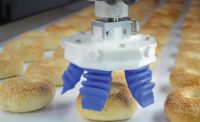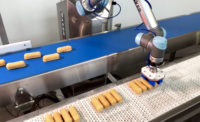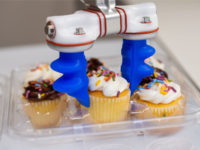New robotics technology is helping to improve primary and secondary packaging applications in snack food and wholesale bakery operations. Areas of innovation include end-of-arm tooling (EOAT), robot learning, sanitation and space optimization. Given the efficiency improvements robotics can bring to manufacturing—and the growing level of flexibility the technology now offers—its use is expanding.
Addressing challenges
Looking at the big picture, U.S. companies ordered robotics at record numbers in 2018, with more non-automotive companies installing robotics than ever before, according to the Robotics Industries Association. A total of 35,880 units were shipped in 2018, a 7 percent increase over 2017. Shipments to non-automotive companies grew 41 percent to 16,702 for the year, with 48 percent growth coming from areas like production of food and consumer goods.
Designing robotics for snack and bakery plants poses a challenge to manufacturers. Some applications require washdown and sanitary robotic system construction. Some may need to operate at elevated temperatures. Cycle time and weight limitations are a concern for most collaborative robotic systems. Total reach required of robot arms must always be considered.
It is important that robotics be highly flexible, yet simple to program for this growing market segment. “Equipment designs should allow for adequate speed, while maintaining necessary features to address the sanitation requirements of the industry, and programming must enable fast changeover, accommodating the flexibility requirements of the bakery/snack producer,” says Dean Elkins, segment leader, material handling, Yaskawa America Inc., Motoman Robotics Div., Miamisburg, OH.
Another challenge is making robotics easy to use and troubleshoot, according to Craig A. Souser, president/CEO, JLS Automation, York, PA. “For many of our applications, we have reduced or eliminated actual robot programming, which makes it easier for us to develop an application. It also gives our customers the ability to create their own recipes.” JLS Automation offers a Next Generation robotics platform that features an integrated motion robot controller with programmable logic controller (PLC) and HMI.
Meeting demands
Despite these challenges, robotics manufacturers are helping snack and bakery operations address changing market demands, according to Elkins. “Bakery/snack producers are seeing market demands move to shorter, high-mix product runs that requires higher degrees of changeover in shorter periods of time,” he notes.
Simplified programming tools, such as lead through teaching, Smart Pendant utilization or PLC-style programming, allow operators and programmers to quickly teach new robot programs specific to product mix, notes Elkins. Food-grade grease mitigates the risk of contamination, and higher robot IP (ingress protection) ratings allow for more thorough cleaning of robots and related automation components.
EOAT is a major factor in improving robotics capabilities, and some manufacturers have taken this concept to the next level. Soft Robotics Inc., Bedford, MA, offers the mGrip, which is designed to improve pick rate and reduce waste through its ability of handle delicate food products. One recent bakery application involves a retrofitted Soft Robotics gripping solution for a customer who previously used a vacuum system to pick up bakery products. The old system was sucking food particles into the air system, causing frequent shutdowns. mGrip eliminated this problem, according to Ashley Levesque, marketing manager.
Other snack and bakery applications for Soft Robotics have included automating the packaging of a high-SKU confectionary operation, case packing of frozen breadsticks and tray packaging of fresh-made dough, notes Levesque. “Soft Robotics technology enables customers to handle delicate, variable products without needing to know the size, shape and weight of the products,” she says.
Flexibility continues to be a driving force in robotic pick-and-place innovations, according to Rick Hoskins, president, Colborne Foodbotics, Lake Forest, IL. He notes that unique EOAT designs are critical to success. “Being able to adapt to baked goods that have wide dimensional tolerances is integral to well designed pick-and-place designs. While this is an application-specific challenge, we find that picking and placing products regardless of dimensional restrictions is important. We do this through unique center picking devices that allow for outer dimensional variations.”
For example, Colborne Foodbotics recently designed a bread and basket handling system for crouton production. The system has multipurpose end effectors that eliminate the need for mechanical handling of baskets and dollies.
Space-saving designs also are important to making robotics work in many snack food and bakery plants, according to Wes Garrett, account manager, FANUC America, Rochester Hills, MI. “Efficient space utilization is always a design consideration when developing solution concepts for robotics and automation. FANUC supports these efforts in many ways, such as with ceiling- and wall-mounted robots. We also offer software tools that allow multiple robots to operate in the same workspace, thus increasing density and improving space utilization.”
New collaborative robots save on production space, often occupying the equivalent space of a human worker, according to Stan Prutz, president/CEO, QDS Systems, Baton Rouge, LA. “Collaborative robotic systems are designed with force and/or proximity sensing to safely slow down and stop if a person gets too close or gets in their way. This eliminates the need to build a safety cage around the robot.”
Advancing capabilities
Many robots are self-monitoring, can analyze errors and provide troubleshooting tips. To a certain degree, vision-guided robotics also is a reality. “Most robotic systems monitor their performance primarily to protect themselves from overload or collisions. In some cases, they are capable of predicting issues prior to the event taking place, helping to minimize unplanned downtime,” Souser says.
FANUC robots are capable of self-monitoring errors and anomalies, according to Garrett. One recent development is FANUC’s Zero DownTime software, a cloud-based analytics industrial IoT product that monitors robot performance and predicts a wide variety of future anomalies, thus helping users avoid unplanned downtime. “Examples of using vision-guided robotics in bakery/snack plants include: locating products on a conveyor in high-speed picking applications, inspection of trays to validate that they are empty before loading product onto them, and finding the location of pans before depalletizing,” he notes.
Space-saving and simple programming qualities are inherent in the latest systems designed by Yaskawa America. “Lightweight and portable, Yaskawa’s MotoMini robot, combined with the ultra-compact YRC1000 micro controller, offers a space-saving solution for small-payload handling applications. The MotoMini’s 0.5-kg payload is well-suited for handling snacks and baked goods, and the 19-inch rack-mount design of the micro controller allows for full function control of robots up to 12-kg in payload,” Elkin says.
Also, the systems have an intelligent Smart Pendant touchscreen that reduces learning time for both experienced and novice programmers due to its conversational, icon-based programming interface, as well as its Smart Frame technology that makes the user the frame of reference, Elkins adds.
BluePrint Automation (BPA), South Chesterfield, VA, also offers space-saving systems to streamline automation and robotic applications. The Spider 200i provides case erecting, packing and sealing in a compact footprint. The Spider 300v can run both vertical and horizontal pack patterns in an open-flow system. “BPA’s integrated case packer, erector and sealer for both RSC and reusable cases (the Spider 200i) saves space versus tradition decoupled systems. These units can fit on 9-ft. centers and still allow plenty of aisle room,” says Jason Hogue, southeast regional sales manager.
Robotics also continue to bring new capabilities to the world of lift trucks and warehouse operations. Yale Material Handling Corp., Greenville, NC, recently introduced the JBT-intelligent robotic reach truck, which uses a combination of sensors and 3D cameras to reach high-level storage locations. The robotic lift truck is capable of autonomously depositing and retrieving loads from locations as high as 30 feet and reaching into double-deep storage. This makes it ideal for distribution centers that face a shrinking labor pool and pressure to maximize vertical storage space to accommodate inventory growth driven by e-commerce, according to Mick McCormick, robotics business leader.
Future developments
What robotics innovations do manufacturers foresee in the near future? Elkins predicts that robots will continue to be more embedded in packaging machines as an OEM feature. “Continued development of sensor technology, including vision and deep learning, will allow for even faster changeover time for varying production runs.” Also, the use of collaborative robotic systems will increase, especially as designs provide higher speeds and better sanitation features.
Prutz also sees a bright future for collaborative robotic systems, which are designed to work with humans in a shared workspace, suggesting that more snack food and wholesale bakery producers should deploy collaborative systems to learn what the technology can do for them. “It is not uncommon that once employees see how these systems can be used to offload mundane, repetitive work, they are the first to suggest new applications for the technology. A relatively low-cost, lightweight collaborative robot can be made portable and easily reprogrammed, allowing companies to try it in a number of different roles within a facility.”




